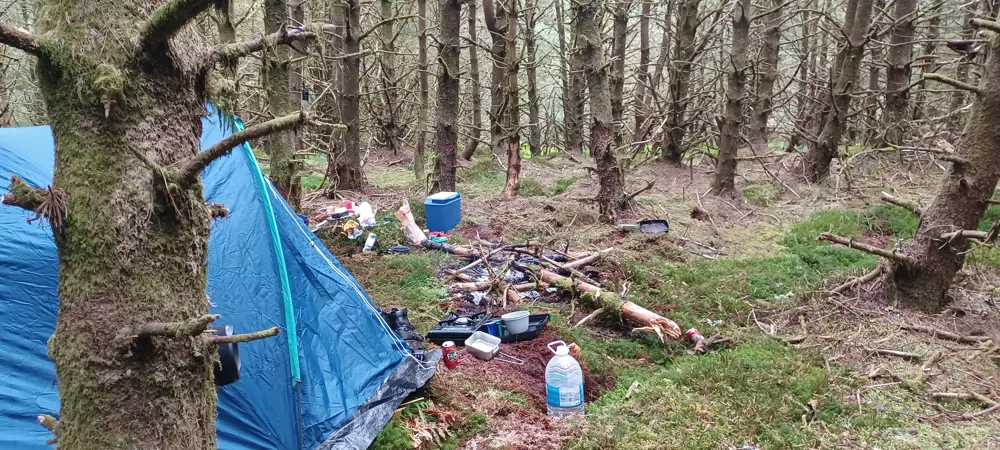Activities that harm
Summer is a great time to get out and explore Scotland’s best natural spaces.
We recently conducted a survey* asking Scottish people if they participated in outdoor activities. These ranged from dog walking, hill walking and water sports to mountain biking, wild camping, wildlife photography and angling.
88% of those surveyed said they used the national forests and land for these activities.
However, 4 out of 10 people also admitted to witnessing or participating in behaviour that might have been harmful to wildlife.
A lot of the time people don’t realise they could be impacting wildlife.
Colin Edwards, our National Environment Manager, is asking people to be mindful of the potential disturbance and harm when they’re out and about. He said:
“Help us to protect what we’ve got, before it’s gone and always follow the Scottish Outdoor Access Code - ‘leave no trace’, take responsibility and don't linger if wildlife is disturbed by your presence.
“None of us set out to deliberately cause harm but sometimes it can be thoughtless behaviour that can cause problems that then ripple out.”

A fire that got out of control in the forest and spread across the floor. Luckily it was put out and didn’t spread to far.
Fire
There are a few things to think about when looking at fire safety. The first is that most wildfires in Scotland are caused by people. Avoid campfires during dry periods and make sure to follow proper safety measures.
The second thing is don't collect deadwood and move wood from forest to forest to start a fire. Deadwood is an essential part of some of our more sensitive habitats, such as our Caledonian pine woods and rainforests. Removing deadwood can disrupt a delicate ecosystem.
Moving firewood can transport tree diseases. We are asking people to use a camp stove to cook food to help prevent any unintentional consequences.
Noise pollution
Nearly half the people surveyed hadn’t realised that their noise could impact the species around them. Many species are very sensitive to noise and disruption.
Using firecrackers or playing loud music while in the forest can impact the health of those around you.
We're asking people to be more aware of the amount of noise they make and be more considerate not only the animals but those living and enjoying the park with you.

Rangers found this campsite totally trashed and left like this. They found it and cleaned it up. Leave no trace is important not only for other visitors but for animals who may find these sites.
Disruption
Six out of 10 people surveyed were not aware of the breeding and nesting seasons of birds and other wildlife in the areas they visit.
Sensitive species such as capercaillie are protected from being disturbed or photographed when they are in lek. Outside this period human distribution, especially by dogs off leads, is impacting this shy species and their ability to reproduce which is affecting the overall health of the population.
More so, we have found in places such as Achray Forest that the extensive network of unofficial bike tracks is causing issues for the raptors, buzzards, sparrow hawks, red kite and goshawk living in the area. Disturbance can cause the birds to abandon their nests at crucial times preventing eggs from being hatched.

A group of trees used for kindling. This is damaging to the trees and can destroy sensitive habitats living on the trees.
Non-responsible photography
Almost 50% of those surveyed said they don’t think about how close they get to wildlife when taking a photo.
Thanks in part to social media we are seeing more and more people seeking out places that are ‘off the beaten track’, not realising that their hobby can disturb wildlife in the area they visit.
Watching and recording wildlife is a popular activity and falls within access rights. Some particular species are protected by law, so it is good to understand the rules around those you are watching or photographing, and the impact your presence is having. Be aware of what responsible photography is, we all have a moral responsibility to give animals plenty of space, stick to viewing platforms and wildlife hides and don’t get too close!
A few small changes can really help the state of Scotland’s wildlife and ecosystems. Please remember to clean up after yourselves, bring reusable containers when you can, and pick up after your dogs.
“Enjoy yourself in Scotland’s forests and wild places but please be mindful of how your actions impact on birds, animals, and sensitive habitats.
*The survey was done in 2023 by Censuswide on behalf of FLS. 1004 Adults were surveyed. The full results can be accessed here: https://charts.censuswide.com/CW11225MP/CW11225MP_VIbox.html
- Water safety
- Wildlife conservation
- Using remote cameras to boost capercaillie conservation efforts in the Highlands